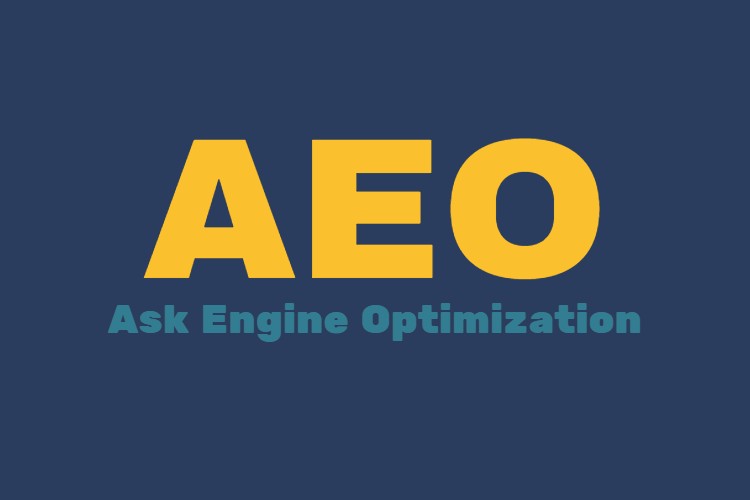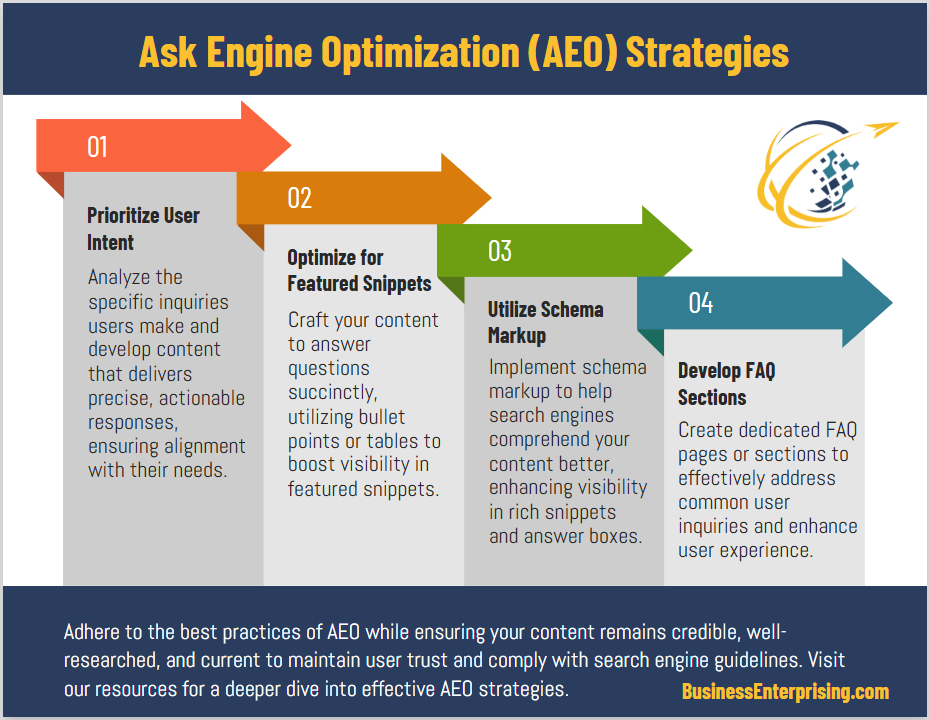
As search engines improve, they prioritize relevant, user-focused content. Therefore, adopting AEO helps your content stand out by addressing specific queries effectively. By using techniques like structured data, conversational tone, and question-based formatting, you can optimize for modern search demands.
Ask Engine Optimization enables you to meet users’ expectations while enhancing your online visibility. With thoughtful implementation, AEO positions your content to succeed in a competitive digital landscape. It’s a valuable approach for businesses aiming to adapt to the changing ways people search for information.
What is AEO and Why is it Important?
Ask Engine Optimization (AEO) focuses on providing clear and direct answers to user queries, transforming how businesses approach search strategies. Unlike traditional SEO, which targets keywords to boost rankings, AEO emphasizes user intent and delivering concise, actionable information. Its goal is to help search engines quickly provide users with relevant answers, often without the need to click through to a website.
AEO is especially important in today’s search environment, where voice search and featured snippets dominate. Users now expect immediate answers, whether they’re typing or speaking their queries. Therefore, AEO prioritizes optimizing content for voice-activated devices and zero-click searches, where answers are displayed directly in search results. This shift highlights how search engines increasingly value convenience and relevance.
Additionally, AEO encourages businesses to create structured, question-and-answer formatted content. By focusing on common questions your audience asks, you can position your content as a trusted resource. This approach not only improves visibility but also strengthens your brand’s authority. As search behavior continues to evolve, adopting Ask Engine Optimization helps you stay competitive and meet the expectations of modern users.
How AEO Aligns with User Intent and Voice Search
Ask Engine Optimization (AEO) aligns closely with user intent by prioritizing content that answers specific questions clearly and efficiently. Unlike traditional SEO, which focuses on keywords and rankings, AEO centers on understanding what users need and delivering direct solutions. This approach helps your content match user queries more accurately, whether they’re searching on desktop or mobile devices.
Additionally, AEO plays a significant role in optimizing for voice search, which continues to grow in popularity. Devices like Siri, Alexa, and Google Assistant rely on conversational queries to provide results. Therefore, AEO emphasizes creating content that mirrors how people speak, making it more relevant for voice-activated searches. For example, instead of targeting “best Italian restaurants,” you might optimize for “What are the best Italian restaurants near me?”
By focusing on user intent, AEO ensures your content meets the evolving expectations of modern searchers. Structured, question-based content increases your chances of appearing in featured snippets or being selected as the top voice search result. This alignment with user needs highlights how Ask Engine Optimization bridges the gap between what users ask and the answers they expect. As a result, adopting AEO strategies helps you stay competitive in a rapidly changing digital landscape.
The Role of Featured Snippets in AEO
Featured snippets play a critical role in Ask Engine Optimization by providing direct answers at the top of search engine results. These snippets often dominate zero-click searches, where users find the information they need without visiting a website. Structuring your content effectively increases the likelihood of capturing this valuable position.
To optimize for featured snippets, focus on creating clear, concise answers to common user questions. Additionally, use headings and subheadings to break down content into easily digestible sections. This organization helps search engines identify the most relevant parts of your page to display as a snippet. For example, a well-formatted FAQ section can significantly improve your chances of appearing.
Another important factor is including structured data, which enhances how search engines interpret your content. Adding schema markup makes it easier for search engines to extract key information and feature it prominently. Additionally, aim to use simple, conversational language that aligns with user intent, especially for voice search.
By prioritizing featured snippets in your AEO strategy, you position your content as the go-to answer for user queries. This approach not only increases visibility but also establishes trust and authority with your audience. Adopting Ask Engine Optimization techniques ensures your content meets modern search demands and stands out in competitive results.
Optimizing Content for Questions and Answers
Optimizing content for questions and answers is a core part of Ask Engine Optimization. This strategy helps your content align with user intent by addressing their specific queries directly. Crafting clear and concise answers improves your chances of being featured in search results or voice responses. Additionally, it establishes your content as a trusted source of information.
Using structured headings and subheadings makes your content easier to navigate for both users and search engines. For instance, organizing content into sections with common questions ensures search engines can quickly identify relevant answers. Including a dedicated FAQ section on your page is another effective way to address multiple queries in one place.
Adopting a conversational tone is also key when creating question-and-answer content. This approach aligns your writing with how users naturally phrase their searches, particularly for voice-activated devices. Additionally, breaking down complex topics into straightforward explanations improves readability and keeps users engaged.
Ask Engine Optimization thrives on content that delivers value by addressing user needs. By using these techniques, you can make your content more accessible, relevant, and discoverable. This strategy not only enhances visibility but also builds trust with your audience, making your site their preferred source for answers.
The Importance of Structured Data and Schema Markup in AEO
Structured data and schema markup play a key role in Ask Engine Optimization by improving how search engines interpret your content. Schema markup adds code to your web pages, providing detailed context about the information you offer. This extra layer of understanding helps search engines deliver your content as direct answers to user queries.
Additionally, structured data enhances your chances of appearing in rich snippets or featured answers. These highly visible positions on search results often drive more traffic to your website. For example, marking up content with FAQ schema allows search engines to highlight your answers directly on the results page. This boosts visibility and makes your content more accessible to users.
Using schema markup also improves voice search optimization. Devices like Alexa and Google Assistant rely on structured data to provide precise, conversational answers. Therefore, adding schema to your content aligns your site with how users interact with voice search technology.
Ask Engine Optimization thrives on clarity and relevance. Incorporating structured data ensures search engines understand your content and rank it appropriately. This not only increases your visibility but also positions your content as a trusted source for answering user questions effectively.
Future Trends in AEO: Preparing for AI-Driven and Conversational Search
Ask Engine Optimization is evolving rapidly as AI and conversational search reshape how users interact with search engines. Voice-activated devices and AI-driven platforms now play a central role in answering queries, making conversational and precise content essential. As search behaviors shift, businesses must adapt their AEO strategies to meet these changing expectations.
Additionally, AI tools like chatbots and smart assistants rely heavily on context and natural language processing. This trend emphasizes the importance of creating content that mirrors conversational tone and directly addresses user questions. Therefore, structuring your content around likely voice search queries helps you stay competitive in this growing space.
Another key trend is the increased personalization of search results. AI analyzes user behavior to deliver answers tailored to specific needs, requiring businesses to focus on intent-driven optimization. Using structured data and FAQ-rich content ensures your website aligns with these personalized search priorities.
Preparing for the future of Ask Engine Optimization involves staying ahead of emerging technologies and adapting your strategies accordingly. By focusing on user intent, conversational tone, and AI-friendly formats, you can maintain visibility and relevance in a competitive search environment. This forward-thinking approach positions your content to meet the demands of modern search behaviors effectively.
Conclusion
Ask Engine Optimization is transforming how businesses reach and engage their audiences in a fast-changing search landscape. As AI and conversational search become more prevalent, adapting your AEO strategies is essential. By focusing on user intent and crafting precise, conversational content, you position your business to meet evolving search demands.
Additionally, leveraging structured data and optimizing for voice-activated devices keeps your content relevant and accessible. These strategies not only enhance visibility but also build trust with users who value quick and accurate answers. Staying proactive in adopting new technologies ensures your business remains competitive.
The future of search prioritizes clarity, relevance, and user-centered solutions. By embracing Ask Engine Optimization, you create opportunities to align with modern search behaviors and improve your overall digital presence. With the right approach, you can thrive in this ever-evolving environment and maintain your edge in delivering value to your audience.



